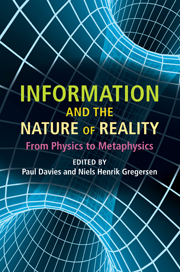Book contents
- Frontmatter
- Contents
- About the authors
- Acknowledgments
- 1 Introduction: does information matter?
- Part I History
- Part II Physics
- Part III Biology
- 7 The concept of information in biology
- 8 What is missing from theories of information?
- 9 Information and communication in living matter
- 10 Semiotic freedom: an emerging force
- 11 Care on Earth: generating informed concern
- Part IV Philosophy and Theology
- Index
- References
8 - What is missing from theories of information?
from Part III - Biology
Published online by Cambridge University Press: 06 December 2010
- Frontmatter
- Contents
- About the authors
- Acknowledgments
- 1 Introduction: does information matter?
- Part I History
- Part II Physics
- Part III Biology
- 7 The concept of information in biology
- 8 What is missing from theories of information?
- 9 Information and communication in living matter
- 10 Semiotic freedom: an emerging force
- 11 Care on Earth: generating informed concern
- Part IV Philosophy and Theology
- Index
- References
Summary
Theories of information that attempt to sort out problems concerning the status and efficacy of its content – as it is understood in thoughts, meanings, signs, intended actions, and so forth – have so far failed to resolve a crucial dilemma: how what is represented could possibly have physical consequences. The legacy of this has been played out in various skeptical paradigms that either conclude that content is fundamentally relativistic, holistic, and ungrounded, or else is merely epiphenomenal and ineffectual except for its arbitrary correlation with the physical properties of the signs that convey it. In this chapter I argue that the apparent conundrums that make this notion controversial arise because we begin our deliberations with the fallacious assumption that in order for the content of information to have any genuine real-world consequences it must have substantial properties, and so must correspond to something present in some form or other. By contrast, I will show that this assumption is invalid and is the ultimate origin of these absurd skeptical consequences.
The crucial property of content that must be taken into account is exactly the opposite: its absence. But how is it possible for a specific absence to have definite causal consequences? A crucial clue is provided by Claude Shannon's analysis of information in terms of constraint on the entropy (possible variety) of signs/signals (Shannon, 1948; Shannon and Weaver, 1949). In other words, the capacity to convey information is dependent on a relationship to something that is specifically not produced.
- Type
- Chapter
- Information
- Information and the Nature of RealityFrom Physics to Metaphysics, pp. 146 - 169Publisher: Cambridge University PressPrint publication year: 2010
References
- 8
- Cited by

